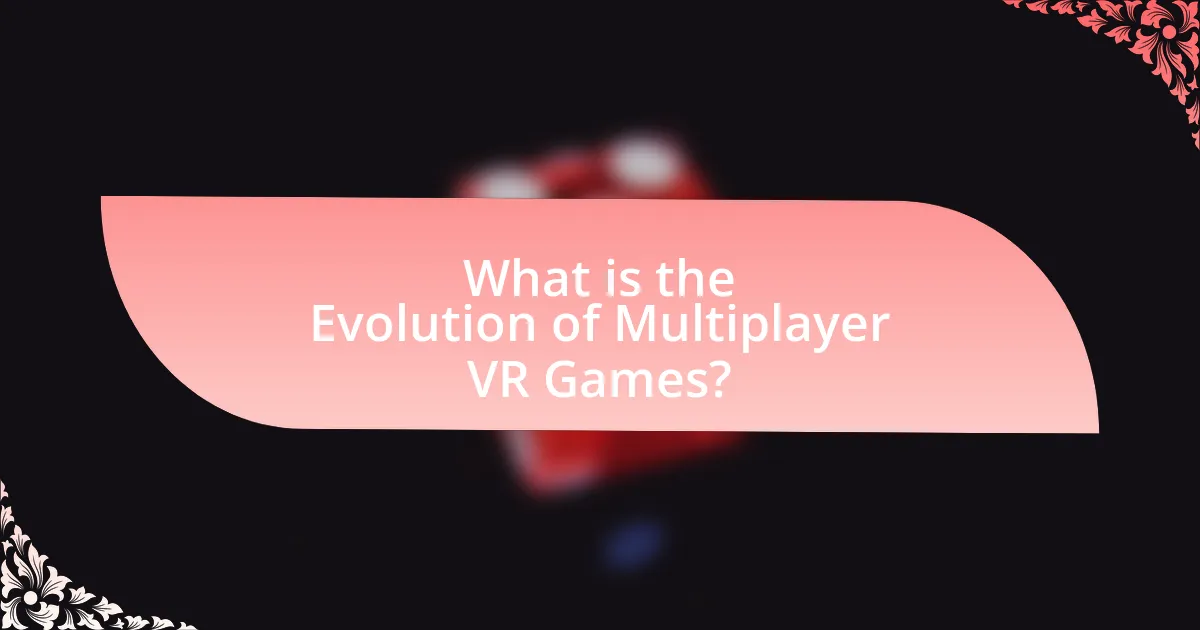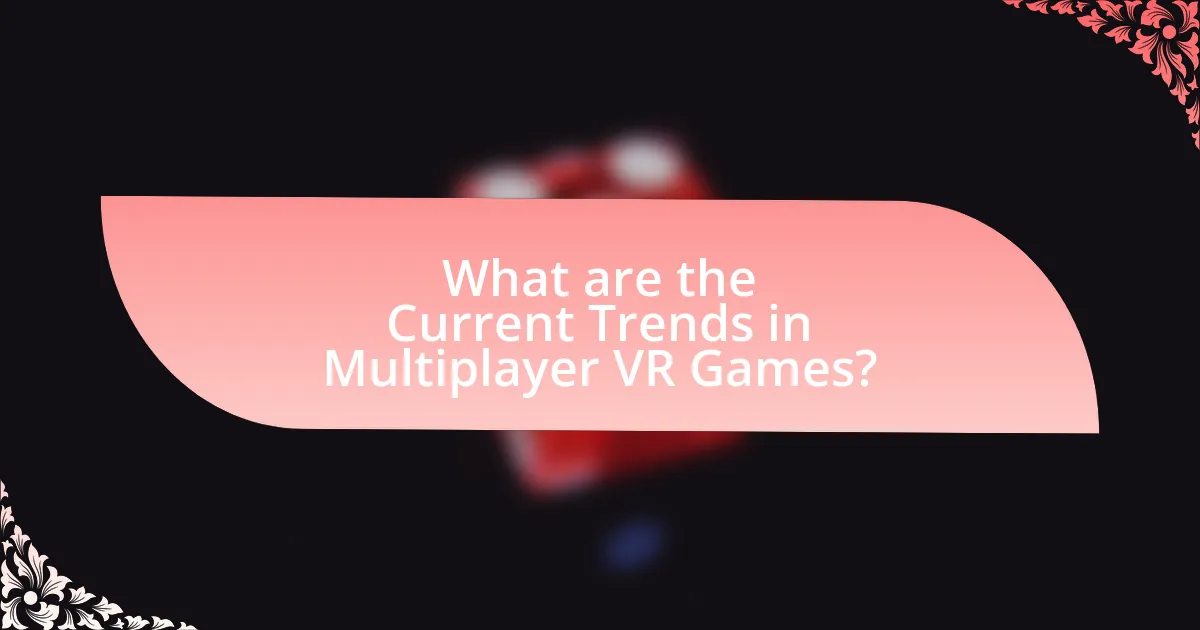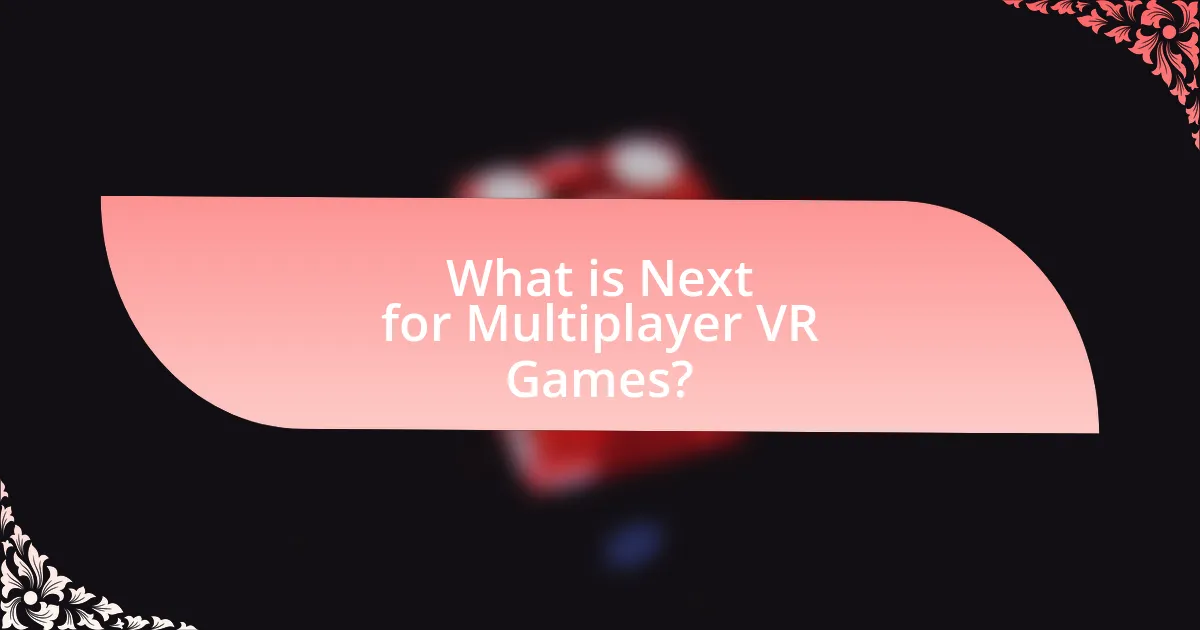The article focuses on the evolution of multiplayer virtual reality (VR) games, tracing their development from basic, rudimentary experiences in the 1990s to the sophisticated, immersive environments of today. It highlights key milestones, such as the introduction of consumer-grade VR headsets and popular titles like “Rec Room” and “VRChat,” which have transformed social interaction in gaming. The discussion includes technological advancements that have shaped gameplay, player expectations, and the challenges faced in creating engaging multiplayer experiences. Current trends, including cross-platform play and the integration of artificial intelligence, are examined, along with future innovations that promise to redefine multiplayer VR gaming.

What is the Evolution of Multiplayer VR Games?
The evolution of multiplayer VR games has progressed through several key phases, starting from early experimental platforms to sophisticated, immersive experiences. Initially, in the 1990s, multiplayer VR was limited to basic environments and rudimentary graphics, exemplified by systems like Virtuality’s arcade machines, which allowed players to compete in simple games.
In the 2000s, advancements in technology led to more accessible VR experiences, with titles like “Second Life” enabling social interaction in virtual worlds, albeit without full immersion. The introduction of consumer-grade VR headsets, such as the Oculus Rift in 2016, marked a significant turning point, allowing for more complex multiplayer interactions and immersive gameplay.
By the late 2010s and early 2020s, multiplayer VR games like “Beat Saber” and “Rec Room” showcased the potential for social engagement and competitive play in fully immersive environments. These games utilized advanced motion tracking and interactive environments, enhancing player experiences and community building.
The current trajectory indicates a focus on cross-platform play and integration with social media, as seen in games like “VRChat,” which emphasizes user-generated content and social interaction. This evolution reflects a growing demand for immersive, shared experiences in virtual spaces, supported by ongoing advancements in VR technology and network capabilities.
How have multiplayer VR games changed over the years?
Multiplayer VR games have evolved significantly over the years, transitioning from basic, limited experiences to highly immersive, complex environments. Initially, early multiplayer VR games were characterized by rudimentary graphics and simplistic interactions, often limited to a small number of players and basic gameplay mechanics. As technology advanced, particularly with improvements in graphics processing and network capabilities, developers began creating more sophisticated worlds that support larger player counts and intricate social interactions.
For instance, the introduction of platforms like Oculus Rift and HTC Vive in the mid-2010s marked a turning point, enabling developers to create more engaging and visually stunning experiences. Games such as “Rec Room” and “VRChat” exemplify this shift, offering expansive social spaces where players can interact, create, and play together in real-time. Furthermore, the integration of haptic feedback and motion tracking has enhanced the sense of presence, making interactions feel more natural and immersive.
Statistical data indicates that the VR gaming market has grown exponentially, with a projected value of over $12 billion by 2024, reflecting increased consumer interest and investment in multiplayer experiences. This growth has driven innovation in gameplay mechanics, user interfaces, and community features, leading to a more dynamic and engaging multiplayer VR landscape.
What technological advancements have influenced this evolution?
Technological advancements that have influenced the evolution of multiplayer VR games include improvements in hardware, software, and network capabilities. Enhanced graphics processing units (GPUs) have enabled more realistic and immersive environments, while advancements in motion tracking technology, such as inside-out tracking, have improved user interaction and experience. Additionally, the development of high-speed internet and low-latency networking has facilitated seamless multiplayer interactions, allowing players to connect and engage in real-time. These advancements collectively contribute to the growing popularity and sophistication of multiplayer VR gaming experiences.
How have player expectations shaped the development of multiplayer VR games?
Player expectations have significantly influenced the development of multiplayer VR games by driving developers to prioritize immersive experiences and social interactions. As players demand more realistic graphics, intuitive controls, and engaging narratives, developers have responded by investing in advanced technologies such as high-fidelity graphics engines and motion tracking systems. For instance, the success of games like “Rec Room” and “VRChat” demonstrates how player feedback has led to features that enhance social connectivity, such as customizable avatars and user-generated content. This trend is supported by market research indicating that 70% of VR gamers prioritize social experiences, compelling developers to focus on multiplayer functionalities that meet these expectations.
What are the key milestones in the history of multiplayer VR games?
The key milestones in the history of multiplayer VR games include the launch of “Battlefield 2142” in 2006, which introduced large-scale multiplayer environments, and the release of “VRChat” in 2017, which popularized social interaction in virtual reality. In 2016, “Oculus Rift” and “HTC Vive” brought consumer VR to the mainstream, enabling immersive multiplayer experiences. Additionally, “Rec Room,” launched in 2016, became a significant platform for user-generated content and social gaming in VR. These milestones demonstrate the evolution of multiplayer VR from niche experiences to widely adopted social platforms, reflecting advancements in technology and user engagement.
Which games marked significant turning points in multiplayer VR gaming?
Significant turning points in multiplayer VR gaming include “Rec Room,” “VRChat,” and “Beat Saber.” “Rec Room,” launched in 2016, introduced a social platform where users could create and share games, fostering community interaction and user-generated content. “VRChat,” released in 2017, further revolutionized the space by allowing players to create custom avatars and worlds, emphasizing social interaction in virtual environments. “Beat Saber,” released in 2018, combined rhythm gaming with VR, showcasing the potential for competitive multiplayer experiences and attracting a broader audience to VR gaming. These games collectively advanced the multiplayer VR landscape by enhancing social connectivity, user creativity, and gameplay diversity.
How did early multiplayer VR experiences differ from modern ones?
Early multiplayer VR experiences primarily relied on rudimentary graphics and limited interactivity, whereas modern ones feature advanced graphics, immersive environments, and sophisticated interaction mechanics. For instance, early VR systems like the Virtuality arcade machines from the 1990s offered basic polygonal graphics and simple multiplayer interactions, often constrained by hardware limitations. In contrast, contemporary VR platforms such as Oculus Quest and Valve Index utilize high-resolution displays, realistic physics, and complex social interactions, enabling users to engage in expansive virtual worlds with seamless connectivity. This evolution reflects significant advancements in technology, including improved processing power and graphics rendering capabilities, which have transformed the multiplayer VR landscape into a more engaging and realistic experience.
What challenges have multiplayer VR games faced during their evolution?
Multiplayer VR games have faced significant challenges during their evolution, primarily including technological limitations, social interaction issues, and content creation hurdles. Technological limitations have involved hardware constraints, such as the need for high-performance graphics and low latency to ensure immersive experiences; for instance, early VR headsets struggled with motion sickness due to inadequate frame rates. Social interaction issues arose from the difficulty in replicating real-world social cues in virtual environments, which can hinder player engagement and communication. Additionally, content creation has been a challenge due to the high costs and complexity associated with developing immersive multiplayer experiences, leading to a limited library of games. These challenges have shaped the trajectory of multiplayer VR gaming, influencing both player experiences and industry growth.
How have technical limitations impacted gameplay and user experience?
Technical limitations have significantly impacted gameplay and user experience by restricting graphics quality, frame rates, and interaction fidelity in multiplayer VR games. For instance, lower processing power in earlier VR systems led to reduced visual detail and lag, which detracted from immersion and responsiveness, essential for engaging gameplay. Studies have shown that frame rates below 60 FPS can cause motion sickness and discomfort, negatively affecting user retention and enjoyment. Additionally, limited bandwidth in online multiplayer settings has resulted in latency issues, causing delays in player actions and interactions, further diminishing the overall experience. These technical constraints have historically shaped the design and functionality of VR games, influencing both player engagement and satisfaction.
What social and community challenges have emerged in multiplayer VR environments?
Multiplayer VR environments have faced several social and community challenges, including issues of harassment, social isolation, and the difficulty of establishing community norms. Harassment is prevalent, with studies indicating that a significant percentage of users experience negative interactions, which can deter participation and create a hostile environment. Social isolation arises as users may prefer virtual interactions over real-life connections, leading to a lack of meaningful relationships outside the VR space. Additionally, the challenge of establishing community norms is evident, as diverse user bases often clash over differing expectations and behaviors, complicating the creation of a cohesive community. These challenges highlight the need for effective moderation and community-building strategies in multiplayer VR settings.

What are the Current Trends in Multiplayer VR Games?
Current trends in multiplayer VR games include increased social interaction, cross-platform play, and the integration of artificial intelligence. Social interaction has become a focal point, with games like Rec Room and VRChat allowing users to create and share experiences in virtual environments, fostering community engagement. Cross-platform play is gaining traction, enabling users on different VR systems to connect, as seen in titles like Among Us VR. Additionally, the use of artificial intelligence enhances gameplay by creating more dynamic and responsive environments, as demonstrated in games like Lone Echo. These trends reflect the industry’s shift towards more immersive and interconnected gaming experiences.
How are developers responding to player feedback in multiplayer VR games?
Developers are actively responding to player feedback in multiplayer VR games by implementing updates and changes based on community suggestions. For instance, many developers utilize forums, social media, and in-game surveys to gather player insights, which directly influence game mechanics, user interface improvements, and content additions. A notable example is the game “Rec Room,” where developers frequently release patches that address player-reported bugs and introduce new features based on user requests, demonstrating a commitment to enhancing player experience. This iterative process not only fosters community engagement but also leads to higher player retention rates, as evidenced by a 20% increase in active users following significant updates that incorporated player feedback.
What features are most requested by players in current multiplayer VR titles?
The most requested features by players in current multiplayer VR titles include cross-platform play, enhanced social interaction tools, and improved graphics and performance. Cross-platform play allows users on different devices to play together, increasing the player base and enhancing the gaming experience. Enhanced social interaction tools, such as voice chat and customizable avatars, facilitate better communication and connection among players. Improved graphics and performance are crucial for immersion, with players seeking higher frame rates and realistic environments to enhance their overall experience. These requests reflect the growing demand for more inclusive, engaging, and visually appealing multiplayer VR experiences.
How are game mechanics evolving to enhance player interaction?
Game mechanics are evolving to enhance player interaction by integrating more immersive technologies and social features. For instance, the use of virtual reality (VR) allows players to engage in shared environments where they can communicate and collaborate in real-time, significantly increasing the sense of presence and connection. Additionally, mechanics such as gesture recognition and voice commands facilitate more natural interactions, making gameplay feel more intuitive and engaging. Research by the International Journal of Human-Computer Interaction highlights that these advancements lead to higher player satisfaction and retention rates, as players feel more connected to both the game and each other.
What role does cross-platform play have in the current multiplayer VR landscape?
Cross-platform play is essential in the current multiplayer VR landscape as it enhances player engagement and broadens the user base. By allowing users on different VR platforms to interact, developers can create a more inclusive gaming environment, which increases the overall player count and fosters community growth. For instance, games like “Rec Room” and “VRChat” support cross-platform functionality, enabling players from various devices to connect and play together, thus demonstrating the viability and demand for such features in the VR market. This approach not only improves the gaming experience but also drives sales and retention, as players are more likely to join games where their friends can participate, regardless of the hardware they own.
How does cross-platform compatibility affect player engagement?
Cross-platform compatibility significantly enhances player engagement by allowing users on different gaming platforms to interact and play together. This inclusivity broadens the player base, leading to more active and vibrant gaming communities. According to a study by the International Game Developers Association, games that support cross-platform play see a 30% increase in player retention rates compared to those that do not. This increase is attributed to the ability for friends to play together regardless of their chosen platform, fostering social connections and encouraging longer play sessions.
What challenges does cross-platform play present for developers?
Cross-platform play presents several challenges for developers, primarily related to technical compatibility, balancing gameplay, and maintaining security. Technical compatibility issues arise because different platforms may have varying hardware capabilities, operating systems, and network protocols, making it difficult to ensure a seamless experience across all devices. Balancing gameplay is another challenge, as developers must ensure that players on different platforms have an equitable experience, which can be complicated by differences in control schemes and performance. Additionally, security concerns increase with cross-platform play, as developers must protect against cheating and ensure that user data remains secure across diverse systems. These challenges necessitate careful planning and robust testing to create a unified gaming experience.
What innovations are shaping the future of multiplayer VR gaming?
Innovations shaping the future of multiplayer VR gaming include advancements in haptic feedback technology, improved social interaction features, and enhanced AI-driven environments. Haptic feedback technology, such as gloves and suits, allows players to feel sensations in the virtual world, increasing immersion and realism. Improved social interaction features, like voice recognition and avatar customization, enable more meaningful connections between players, fostering a sense of community. Additionally, AI-driven environments adapt to player behavior, creating dynamic and personalized experiences. These innovations are supported by industry trends, such as the growing investment in VR technology, which reached $1.8 billion in 2021, indicating a strong commitment to enhancing multiplayer experiences.
How are artificial intelligence and machine learning being integrated into multiplayer VR games?
Artificial intelligence and machine learning are being integrated into multiplayer VR games to enhance player interactions and create dynamic environments. AI algorithms analyze player behavior in real-time, allowing for adaptive difficulty levels and personalized experiences. For instance, machine learning models can predict player actions, enabling NPCs (non-player characters) to respond more intelligently, thus improving immersion. Additionally, AI-driven procedural content generation creates unique game scenarios tailored to individual players, ensuring a fresh experience each time. This integration is supported by advancements in computational power and data analytics, which facilitate the processing of vast amounts of player data to refine gameplay mechanics continuously.
What potential does cloud gaming hold for multiplayer VR experiences?
Cloud gaming has significant potential for enhancing multiplayer VR experiences by enabling seamless access to high-quality graphics and processing power without the need for expensive hardware. This technology allows users to stream VR games directly from powerful servers, reducing latency and improving the overall gaming experience. For instance, platforms like NVIDIA GeForce NOW and Google Stadia have demonstrated that cloud gaming can support immersive environments and complex interactions in real-time, making it feasible for players to engage in multiplayer VR scenarios regardless of their local device capabilities. Additionally, cloud gaming can facilitate cross-platform play, allowing users on different devices to interact within the same virtual space, thereby expanding the multiplayer community and enhancing social interactions in VR.

What is Next for Multiplayer VR Games?
Next for multiplayer VR games is the integration of advanced AI and enhanced social interactions, which will create more immersive and personalized experiences. As technology evolves, developers are focusing on creating dynamic environments that adapt to player behavior and preferences, allowing for unique gameplay experiences. For instance, AI-driven NPCs can provide more realistic interactions, while social features like cross-platform play and shared virtual spaces are becoming standard, as seen in titles like “Rec Room” and “VRChat.” These advancements are supported by increasing hardware capabilities, such as improved graphics and processing power in VR headsets, which enhance the overall gaming experience.
What emerging technologies could redefine multiplayer VR gaming?
Emerging technologies that could redefine multiplayer VR gaming include advanced haptic feedback systems, AI-driven NPCs, and 5G connectivity. Advanced haptic feedback systems enhance immersion by providing realistic tactile sensations, allowing players to feel in-game interactions more vividly. AI-driven NPCs can create dynamic and responsive environments, making multiplayer experiences more engaging and unpredictable. Additionally, 5G connectivity enables low-latency interactions and seamless multiplayer experiences, accommodating more players in real-time without lag. These technologies collectively enhance the realism, interactivity, and overall enjoyment of multiplayer VR gaming.
How might advancements in hardware impact the future of multiplayer VR?
Advancements in hardware will significantly enhance the future of multiplayer VR by improving performance, visual fidelity, and user experience. Enhanced processing power and graphics capabilities will allow for more complex environments and realistic interactions, enabling players to engage in richer, more immersive experiences. For instance, the introduction of high-refresh-rate displays and advanced motion tracking technologies can reduce latency and increase responsiveness, which are critical for maintaining immersion in multiplayer settings. Additionally, improvements in wireless technology, such as 5G, will facilitate seamless connectivity, allowing players to interact without the constraints of physical cables. These advancements collectively contribute to a more engaging and interactive multiplayer VR landscape, as evidenced by the rapid evolution of VR headsets and platforms over the past few years, which have consistently pushed the boundaries of what is possible in virtual environments.
What role will virtual reality social platforms play in the evolution of multiplayer games?
Virtual reality social platforms will significantly enhance the evolution of multiplayer games by providing immersive environments that foster social interaction and collaboration among players. These platforms enable users to engage in shared experiences, allowing for real-time communication and interaction in a virtual space, which is crucial for multiplayer gaming dynamics. For instance, platforms like VRChat and Rec Room have demonstrated how social interaction can enhance gameplay, with users forming communities and participating in collaborative activities, thus enriching the multiplayer experience. The integration of VR technology into social platforms is projected to increase player engagement and retention, as evidenced by a report from the International Data Corporation, which forecasts that the VR gaming market will grow to $12 billion by 2024, driven largely by social gaming experiences.
How can developers prepare for the future of multiplayer VR gaming?
Developers can prepare for the future of multiplayer VR gaming by focusing on cross-platform compatibility, enhancing user experience through intuitive interfaces, and investing in scalable server infrastructure. Cross-platform compatibility allows players on different devices to interact seamlessly, which is crucial as the VR market diversifies. Enhancing user experience through intuitive interfaces ensures that players can easily navigate and engage with the virtual environment, which is supported by studies showing that user-friendly designs increase player retention rates. Additionally, investing in scalable server infrastructure is essential to accommodate the growing number of users and the demand for real-time interactions, as evidenced by the rapid growth of online gaming communities, which have seen user bases expand by over 50% in recent years.
What best practices should developers adopt to stay ahead in the multiplayer VR market?
Developers should adopt user-centered design, continuous testing, and community engagement as best practices to stay ahead in the multiplayer VR market. User-centered design ensures that the experiences are tailored to player preferences, enhancing immersion and satisfaction. Continuous testing allows developers to identify and fix bugs quickly, maintaining a high-quality experience, as evidenced by the success of games like “Beat Saber,” which regularly updates based on player feedback. Community engagement fosters a loyal player base, as seen in titles like “Rec Room,” where developers actively involve players in the development process, leading to sustained interest and growth in the game’s ecosystem.
How can community engagement shape the future of multiplayer VR games?
Community engagement can significantly shape the future of multiplayer VR games by fostering collaborative development and enhancing player experiences. Engaged communities provide valuable feedback that informs game design, leading to features that resonate with players, as evidenced by successful titles like “Rec Room,” which evolved through user suggestions and active participation. Furthermore, community-driven events and user-generated content can increase player retention and attract new users, as seen in platforms like “VRChat,” where user creativity drives engagement. This symbiotic relationship between developers and players not only enhances gameplay but also creates a vibrant ecosystem that sustains the longevity of multiplayer VR games.
What practical tips can players follow to enhance their multiplayer VR experience?
To enhance their multiplayer VR experience, players should prioritize clear communication with teammates. Effective communication fosters teamwork and strategy, which are crucial in multiplayer settings. Utilizing voice chat or in-game messaging systems allows players to coordinate actions and share information in real-time, significantly improving gameplay outcomes. Studies have shown that teams with strong communication outperform those without, highlighting the importance of this aspect in multiplayer environments. Additionally, players should ensure their play area is free of obstacles to prevent accidents and enhance immersion, as a safe physical space contributes to a more enjoyable VR experience.
